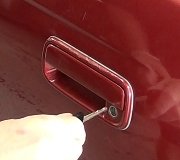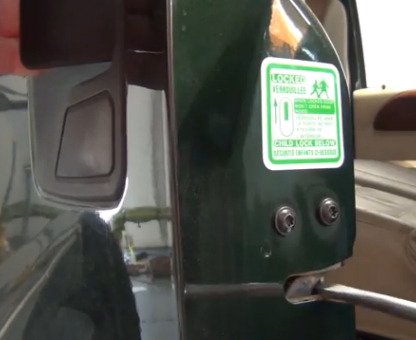The reason it doesn't start is because the security light is on it has disabled the fuel injectors.I posted below how it work's let's try relearning the pass lock sensor. Here is how you do it let me know what happens. So we can go from there.
10 MINUTE LEARN PROCEDURE
1. Turn ON the ignition, with the engine OFF.
2. Attempt to start the engine, then release the key to ON, vehicle will not start.
3. Observe the SECURITY telltale, after approximately 10 minutes the telltale will turn OFF.
4. Turn OFF the ignition, and wait 5 seconds.
5. The vehicle is now ready to relearn the Passlock Sensor Data Code and/or passwords on the next ignition switch transition from OFF to CRANK.
6. Start the engine, the vehicle has now learned the Passlock Sensor Data Code and/or password.
VEHICLE THEFT DETERRENT (VTD) DESCRIPTION AND OPERATION
Passlock SYSTEM
The Passlock System is provided in order to prevent vehicle theft if the ignition lock cylinder is forced to rotate or the ignition switch is operated while separated from the ignition lock cylinder case. If starting is attempted without authorization from the Passlock System, the powertrain control module (PCM) will disable the fuel injectors causing the engine to stall immediately after starting.
The components of the Passlock System are as follows:
* The ignition lock cylinder and key
* The ignition lock cylinder case, including the Passlock Sensor
* The ignition switch
* The body control module (BCM)
* The security indicator on the instrument cluster
* The powertrain control module (PCM)
Ignition Lock Cylinder Case, Including The Passlock Sensor
The ignition lock cylinder fits inside the ignition lock cylinder case and operates the ignition switch when turned by a key with the proper mechanical cut. When the ignition key is used to turn the ignition lock cylinder to crank, start, a magnet on the lock cylinder passes close to the Passlock Sensor within the ignition lock cylinder case. The magnet activates the Security Hall Effect Sensor in the Passlock Sensor which completes a circuit from the security sensor signal circuit through a resistor to the security sensor low reference circuit. The resistance value will vary from vehicle to vehicle.
If a magnet from outside of the ignition lock cylinder case is used to attempt to steal the vehicle, the Tamper Hall Effect Sensor will be activated. This completes a circuit from the security sensor signal circuit through a tamper resistor to the security sensor low reference circuit bypassing the security resistor. If the ignition switch is forced to rotate without the correct key, or if the ignition lock cylinder is removed by force, the Passlock Sensor will be damaged and will not operate.
Ignition Switch
The ignition switch contains the wiring and electrical switching portion of the column mounted ignition assembly. The ignition switch includes wiring pigtails which connect it to the base of column connector, the Passlock Sensor on the ignition lock cylinder case, and other components. The wiring for the Passlock Sensor is unaffected by ignition switch position. The electrical switch portion is operated by the key and lock cylinder when they are rotated within the ignition lock cylinder case. The ignition switch operates the crank relay regardless of the status of the Passlock System.
Body Control Module (BCM)
The BCM contains the logic of the theft deterrent system. The BCM provides the battery positive voltage to operate the Passlock Sensor. The BCM also measures the voltage of the security sensor signal circuit. The voltage measured will indicate whether the Passlock Sensor has been activated and whether the resistance value from the sensor is a valid value or the tamper value. If voltage measured is in the valid range, the BCM compares this voltage, voltage code, to a previously learned voltage code. If the voltage codes match, the BCM sends a class 2 message containing a password to the PCM. If the voltage codes do not match, or the voltage is in the Tamper range, or there is a circuit fault, the BCM will not send the correct password to the PCM, and the vehicle will not start.
Powertrain Control Module
The powertrain control module (PCM) contains the remainder of the logic of the theft deterrent system. If a class 2 message containing a valid password is received from the BCM, the PCM will continue to allow the fuel injectors to operate. The PCM will allow the fuel injectors to operate until it decides there is no valid password coming from the BCM. If the PCM does not receive a class 2 message, or receives a class 2 message with an incorrect password, the engine will crank and will not run or will start and stall immediately.
THEFT SYSTEM INDICATOR
The IPC illuminates the theft deterrent indicator as determined by the theft deterrent system. The IPC receives a class 2 message from the BCM requesting illumination.
* The vehicle theft deterrent (VTD) system requests the IPC to illuminate the indicator only when the ignition switch is ON.
* The content theft deterrent (CTD) system requests the IPC to illuminate the indicator only when the ignition switch is in the OFF or ACC positions or during RAP.
* The body control module performs the displays test at the start of each ignition cycle. The indicator illuminates for approximately 3 seconds.
FUEL LOCKOUT CYCLE
When it receives a password which is incorrect or a password which indicates tamper and the PCM disables the fuel injectors, the fuel injectors remain disabled for 10 minutes even if the ignition switch is turned from the RUN position to the OFF position.
CHANGING THE Passlock COMPONENTS
The following components contain codes or passwords, or must learn codes or passwords for the Passlock system to allow the vehicle to start:
* The ignition lock cylinder case
* BCM
* The powertrain control module (PCM)
If any of these parts are replaced, a learn procedure must be performed. Refer to Programming Theft Deterrent System Components. If parts are replaced and a learn procedure is not performed, the engine will crank and will not run or will start and stall immediately.
Friday, January 29th, 2021 AT 10:23 AM
(Merged)



